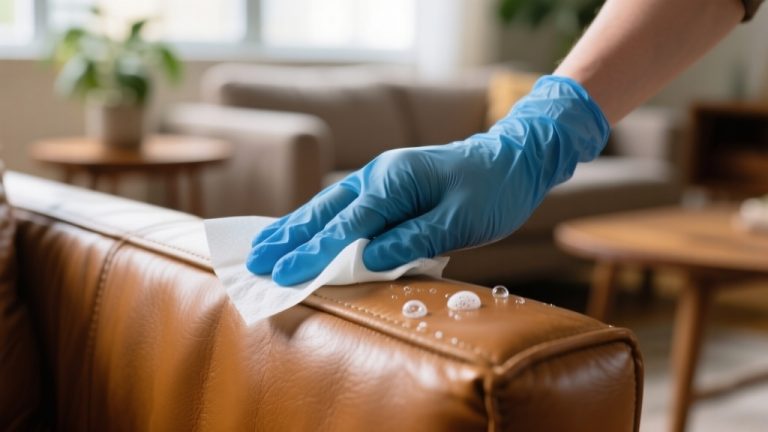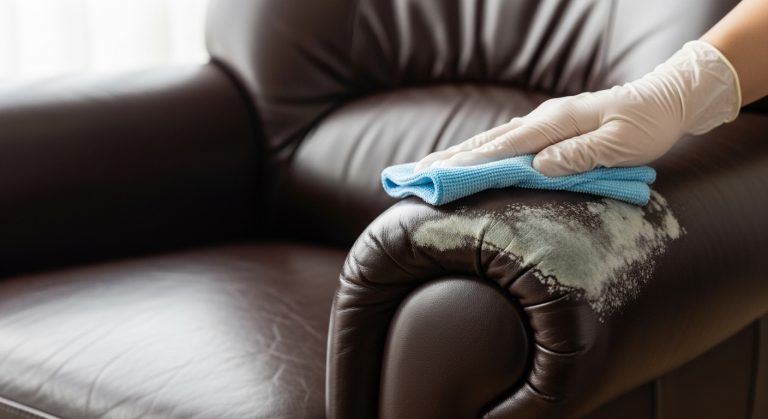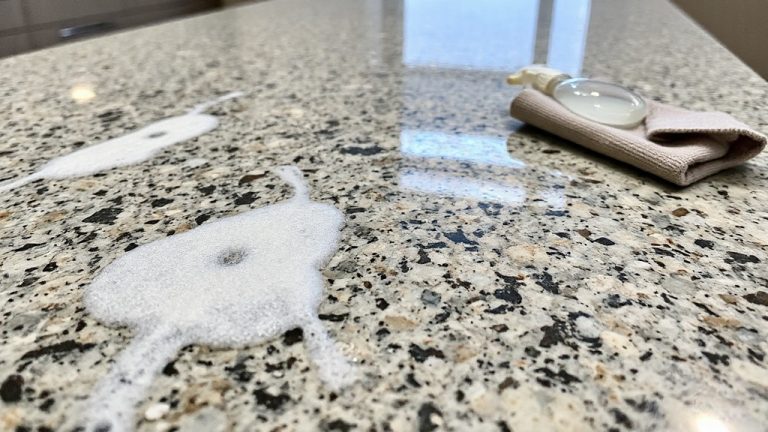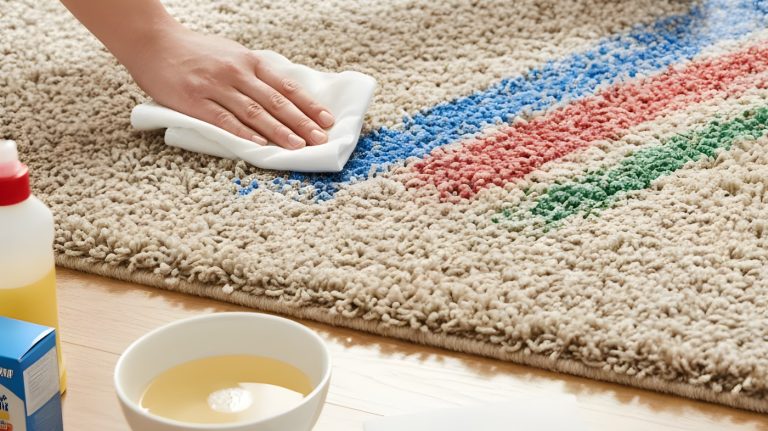Can You Bleach Wool? Safe Methods and Tips for Home Use
You can bleach wool, but you need to avoid harsh chlorine bleaches because they break down keratin, causing brittleness and fiber damage.
Instead, use hydrogen peroxide at low concentrations (≤3%) and controlled temperatures to gently remove impurities without weakening the fiber.
Proper neutralization after bleaching is vital to stabilize wool’s pH, preventing ongoing degradation and color loss.
If you want to optimize wool bleaching safely and maintain fiber strength, keep exploring the best practices and chemical controls involved.
Key Takeaways
- Wool can be bleached safely using mild oxidizers like hydrogen peroxide at low concentrations (≤3%) to avoid fiber damage.
- Chlorine bleach is harmful to wool, causing fiber weakening, brittleness, yellowing, and environmental hazards, and should be avoided.
- Proper neutralization after bleaching with acids like vinegar halts chemical reactions and preserves wool’s strength and color quality.
- Pre-scouring wool and controlling bleaching parameters (temperature, pH, time) improves bleaching effectiveness and minimizes fiber degradation.
- Using mordants and stabilizers during bleaching helps protect wool protein structures and ensures even, colorfast results.
Understanding Wool Fiber Composition
Although wool fiber appears uniform to the naked eye, its composition reveals a complex structure of distinct layers: cuticle, cortex, and medulla. Each layer contributes specific mechanical and chemical properties.
The cuticle is composed of overlapping scale-like cells coated with 18-methyleicosanoic acid. This structure provides water repellency and mechanical protection. The overlapping scales face away from the root end, increasing friction when fibers rub in one direction, which aids in dirt expulsion and felting (cuticle scales). Tools designed with multi-surface compatibility can help maintain wool textiles by effectively removing dirt without damaging fibers.
Beneath lies the cortex, the fiber’s core structure, which contains orthocortex and paracortex cells. These have different chemical properties that influence crimp.
The cortex’s macrofibrils and microfibrils are embedded in a sulfur-rich protein matrix. This configuration confers strength, elasticity, moisture absorption, and fire resistance.
The medulla, usually present in coarser fibers, consists of a trichohyalin protein matrix.
Keratin proteins, linked by disulphide bonds, form twisted molecular chains that underpin wool’s elasticity and resilience.
Additionally, the cell membrane complex facilitates dye uptake but is vulnerable to chemical breakdown.
Why Chlorine Bleach Is Harmful to Wool?
Why does chlorine bleach pose such a significant threat to wool fibers?
Wool’s keratin protein structure is highly vulnerable to chlorine’s hydrolytic and oxidative effects.
Chlorine bleach breaks peptide bonds within keratin, causing chemical degradation that weakens fiber tensile strength and integrity.
This leads to physical damage; fibers become brittle, fuzzy, and prone to shedding.
Chlorine also disrupts the wool fiber scales, increasing felting and shrinkage risks.
Visually, chlorine rapidly strips wool’s color, causing yellowing, uneven discoloration, and loss of natural luster.
Beyond fiber damage, chlorine bleaching generates toxic byproducts like dioxins, posing environmental and health hazards.
Because bleach exposure causes wool to disintegrate even more when left in contact for longer periods, the damage can be severe and permanent fiber disintegration.
To prevent permanent damage, it is important to avoid using harsh chemicals and instead rely on regular maintenance practices suitable for delicate fibers.
Due to these irreversible effects on wool’s structural and aesthetic properties, using chlorine bleach compromises wool’s durability, appearance, and sustainability, making it a harmful choice for wool treatment.
Safe Bleaching Agents for Wool Treatment
When it comes to bleaching wool safely, hydrogen peroxide is your go-to agent. To keep those fibers in tip-top shape, make sure to stick with concentrations at or below 3%. This way, you can achieve a lighter color without compromising the integrity of the wool. Maintaining proper ventilation during the process also helps prevent any adverse effects on the fibers and ensures a safer working environment with minimal chemical exposure.
Now, let’s talk temperature. It’s really important to keep a close eye on it during the bleaching process. Finding that sweet spot will help you optimize the bleaching efficiency while making sure the wool doesn’t get damaged. Products containing higher peroxide concentrations (above 3%) are generally not recommended for consumer use due to the risk of color changes and fiber damage higher peroxide risk.
And don’t forget about the final step! After you’ve done the bleaching, it’s crucial to properly neutralize the wool. This not only stabilizes the fibers but also prevents any lingering chemical effects. You definitely want to avoid any surprises later on!
Hydrogen Peroxide Use
How does hydrogen peroxide stand out as a bleaching agent for wool? You’ll find it’s preferred over chlorine-based bleaches due to its milder oxidative action, which whitens fibers by breaking down color impurities without severe structural damage. Its quick decomposition also reduces the risk of fabric damage compared to harsher chemicals.
Typically used at around 3% concentration, hydrogen peroxide decomposes into water and oxygen, leaving no harmful residue. Its efficacy increases in alkaline conditions (pH 9–11), often buffered with sodium pyrophosphate to stabilize the solution and minimize fiber degradation. Stabilized bleaching liquors prevent decomposition caused by trace metals, ensuring consistent bleaching performance.
You should pre-scour wool before immersion and follow with acid neutralization to restore fiber pH. While prolonged exposure or higher concentrations risk tensile strength loss, controlled parameters ensure effective whitening without compromising fiber integrity. Additionally, proper application safety measures, such as avoiding oversaturation and testing on small fabric areas, help protect delicate fibers.
Temperature and Concentration
Although hydrogen peroxide remains the most widely approved bleaching agent for wool, its effective use depends heavily on maintaining specific temperature and concentration parameters.
For ideal bleaching, maintain temperatures between 60°C and 85°C, with concentrations not exceeding 3% to prevent fiber damage.
Alternative agents like sodium hydrosulfite require around 70°C and 1%-3% concentration.
Potassium permanganate demands careful dilution and temperature monitoring to avoid uneven bleaching.
| Agent | Temperature (°C) | Concentration (%) |
|---|---|---|
| Hydrogen Peroxide | 60 – 85 | ≤ 3 |
| Sodium Hydrosulfite | ~70 | 1 – 3 |
| Potassium Permanganate | Variable, controlled | Diluted solutions |
Strict adherence to these parameters guarantees effective bleaching while preserving wool’s structural integrity. It is also important to test cleaning solutions on a small, hidden area before full application to avoid potential fiber damage.
Neutralization After Bleaching
Because residual bleaching agents can continue to degrade wool fibers if not properly neutralized, you must promptly adjust the bath pH and remove leftover oxidizers after the bleaching process.
Maintaining the bath pH between 7.5 and 9.5 prevents alkaline damage, while neutralizing residual peroxide halts ongoing oxidation. You should use mild acids like formic or acetic acid to acidify the bath and rinsing with acidified water to remove residual chemicals. It is important to note that commercial processing aids may alter wool pH but do not affect the test’s outcome, highlighting wool’s acidic nature. Proper moisture control during rinsing helps prevent fiber damage and ensures optimal treatment.
Key steps include:
- Apply buffering agents such as tetrasodium pyrophosphate to stabilize pH during bleaching.
- Immediately rinse wool with acidified water to quench reactive oxygen species and neutralize alkalinity.
- Verify neutralization effectiveness using peroxide and pH indicator strips to ensure fiber preservation.
This precise neutralization safeguards wool’s keratin structure and prepares fibers for subsequent processing.
Industrial Methods of Wool Bleaching
When you examine industrial wool bleaching, you’ll find that the process relies heavily on carefully controlled chemical agents and processing routes to achieve superior whiteness without compromising fiber integrity.
Hydrogen peroxide serves as the primary bleaching agent, stabilized with alkaline activators like soda ash to optimize whitening while minimizing keratin damage. Surfactants with emulsifying, dispersing, and wetting properties are often used as auxiliary agents to enhance bleaching effectiveness. Proper pH control during bleaching is essential to maintain fiber strength and avoid damage.
Batch processing dominates, immersing wool in baths at 49–60°C with controlled pH (7.0–10.0) to balance bleaching efficacy and fiber preservation.
Pad-batch methods allow ambient temperature bleaching over extended dwell times, enhancing uniformity and fiber safety.
Sodium hypochlorite use is limited due to fiber degradation and environmental issues.
Post-bleach neutralization acidifies wool to pH 4.5–5.5, stabilizing fibers.
Optical brighteners often supplement peroxide to meet high whiteness standards, while liquor ratios and temperature control maintain uniform bleaching critical for subsequent dyeing.
Home Bleaching Techniques Using Hydrogen Peroxide
If you want to bleach wool at home, hydrogen peroxide offers a controllable and effective option, provided you select the correct concentration and follow proper preparation steps.
Typically, 3% hydrogen peroxide is safest for delicate fibers, while 10% provides stronger bleaching but risks damage.
Before bleaching, scour wool with hot water and mild detergent to remove oils and impurities, then pre-soak it to ensure even bleaching. Just as with unlacquered brass, it is important to inspect fibers carefully before applying any chemical treatment.
Key steps for home bleaching include:
- Prepare a neutral to slightly acidic bleaching solution (pH 6.5–7.3) with peroxide and a wetting agent like Synthrapol. Always test samples before large-scale application to ensure fabric safety.
- Soak wool 16–24 hours at room temperature, keeping it fully submerged and occasionally agitating.
- Rinse thoroughly and neutralize with dilute acetic acid or vinegar to halt bleaching and protect fibers.
Strict timing and concentration control minimize fiber weakening and uneven results.
The Role of Mordants in Wool Bleaching
Hydrogen peroxide bleaching effectively lightens wool fibers, but controlling its action within pigmented areas requires additional chemical intervention.
You rely on mordants, metallic salts like ferrous sulfate, to bind melanin granules, localizing bleaching and protecting fiber proteins. This selective catalysis generates hydroxyl radicals that degrade pigment without broadly weakening wool structure.
Proper washing removes unbound mordants, preventing damage.
Steam cleaning can be a complementary method to maintain fiber integrity after bleaching by gently removing residual chemicals with high-temperature steam.
| Mordant Type | Effect on Wool |
|---|---|
| Ferrous sulfate | Catalyzes selective bleaching |
| Alum | Mild, compatible mordant |
| Chrome compounds | Vibrant, colorfast hues |
| Plant tannins | Natural, eco-friendly option |
You control mordant concentration and application method to optimize bleaching precision and colorfastness while minimizing fiber degradation.
Risks of Over-Bleaching Wool Fibers
When you over-bleach wool, you run the risk of making the fibers really brittle and prone to breakage. This happens because the oxidative agents used in the bleaching process can break down important disulphide bonds.
It’s kind of like weakening the very structure that holds everything together. Since wool is a protein-based fiber, it reacts negatively with chlorine bleach, which can cause irreversible damage and discoloration, so it is best to avoid using chlorine bleach on wool altogether to maintain its integrity.
Not only that, but this molecular damage can also lead to permanent shrinkage and felting. And let’s be honest, nobody wants that. It ultimately compromises the dimensional stability of the wool. Proper care and avoiding harsh chemicals is essential to prevent fiber degradation.
Fiber Brittleness and Breakage
A critical concern during wool bleaching is fiber brittleness, which markedly raises the risk of breakage. Oxidative agents like hydrogen peroxide can disrupt keratin bonds and strip protective lipid layers, weakening fiber integrity. Over-bleaching accelerates this degradation, making fibers prone to fracture during processing.
To minimize brittleness and maintain wool strength, consider the following:
- Control bleaching parameters. Temperature near 70°C and limited exposure time reduce oxidative damage.
- Avoid excessive alkalinity that breaks down keratin protein structures beyond color removal.
- Employ post-bleaching treatments like microbial enzymes to partially restore tensile strength.
Permanent Shrinkage and Felting
Although bleaching is essential for lightening wool fibers, over-bleaching poses significant risks of permanent shrinkage and felting due to damage to the fiber’s surface scales.
Harsh oxidizers, particularly chlorine, etch and degrade these microscopic scales, weakening the cuticle and removing the protective lipid layer.
This damage enhances fiber interlocking during mechanical agitation or washing, causing irreversible felting shrinkage.
While resin coatings like Hercosett can mitigate felting by smoothing fiber surfaces and blocking scale engagement, they can’t fully reverse scale descaling or prevent shrinkage entirely.
You must also control washing temperature and agitation carefully; higher temperatures and prolonged cycles exacerbate shrinkage risks once scales are compromised.
Ultimately, over-bleaching induces permanent physical alterations that increase wool’s propensity to felt and shrink, demanding precise processing to preserve fiber integrity.
Additionally, wool pretreatment, including thorough scouring with alkali solutions, is essential to remove dirt and grease that may otherwise affect bleaching uniformity and fiber quality pretreatment essentials.
Differences Between Bleaching Wool and Plant-Based Fibers
Since wool and plant-based fibers differ fundamentally in chemical composition and structure, their bleaching processes require distinct approaches.
Wool, a protein fiber rich in keratin, demands milder, acidic to neutral hydrogen peroxide treatments at lower temperatures to prevent strength loss and scale damage.
In contrast, plant fibers like cotton tolerate harsher, alkaline peroxide bleaching at near-boiling temperatures.
Key differences include:
- Chemical Reactivity: Wool targets melanin pigments and lipids; plant fibers break down cellulose chains.
- Process Conditions: Wool requires shorter, cooler treatments; plant fibers endure longer, hotter baths.
- Structural Impact: Wool’s lipid removal enhances dye uptake but risks fiber weakening; plant fibers maintain mechanical integrity better.
Understanding these distinctions helps you optimize bleaching without compromising wool’s delicate structure.
The Importance of Neutralizing Wool After Bleaching
It’s really important to neutralize wool right after you’ve bleached it. Why? Well, if you don’t, those ongoing chemical reactions can start to break down the fiber’s protein structure. And that’s not something you want.
To effectively halt the bleaching reaction, you can immerse the fabric quickly into a hydrogen peroxide solution after applying bleach. So, what do you do? You can use acid solutions like diluted acetic acid or even good old household vinegar. This helps to restore the wool’s natural acidic pH, which is crucial for stabilizing the material before you go on to any further processing.
Now, if you’re thinking about skipping this step, I’d really advise against it. Not neutralizing the wool can lead to some pretty serious issues like fiber brittleness, uneven dyeing, and a significant reduction in durability.
Trust me, taking the time to neutralize is worth it!
Why Neutralization Matters?
Why does neutralization play a crucial role immediately following wool bleaching?
When you neutralize wool, you halt ongoing alkaline and oxidative reactions that can degrade keratin fibers.
Without it, peptide bonds and disulfide cross-links break down, weakening tensile strength and elasticity.
Residual alkali accelerates yellowing and reduces dye uptake, compromising quality.
Key reasons why you must neutralize wool post-bleaching:
- Preserves Fiber Integrity: Stops hydrolysis and oxidation that cause brittleness and fiber failure.
- Ensures Consistent Dyeability: Stabilizes pH, preventing uneven color absorption and harsh handle.
- Optimizes Production Efficiency: Minimizes waste, avoids batch inconsistencies, and reduces need for corrective processing.
Neutralization is essential to maintain wool’s structural and aesthetic properties, guaranteeing reliable performance in downstream applications.
Neutralizing Agents Used
Although neutralization is critical after bleaching wool, selecting the appropriate neutralizing agent depends on the type of bleach used and the desired fiber protection.
For chlorine-based bleaches, sodium thiosulfate effectively halts oxidative damage by chemically reducing residual chlorine. Bleach-Stop, composed of sodium thiosulfate, is specifically designed to neutralize the bleaching action of regular bleach and prevent fabric deterioration over time by stopping ongoing bleach activity.
Acetic acid or diluted household vinegar neutralizes alkaline bleach residues, maintaining pH balance and preserving fiber integrity.
Hydrogen peroxide can serve as a milder bleaching and neutralizing agent when applied in controlled concentrations.
You should immerse wool in the neutralizing solution, typically warm water with precise agent dosing, for about 10 minutes to ensure full chemical quenching.
Uniform application and thorough rinsing afterward remove residual chemicals, preventing ongoing oxidation.
Be cautious with concentration and exposure time, as improper neutralization risks fiber degradation, discoloration, and weakened wool structure.
These are vulnerable due to their protein-based composition.
Tips for Preserving Wool Strength During Bleaching
When preserving wool strength during bleaching, selecting the appropriate bleaching agent and controlling processing conditions are critical.
You should use hydrogen peroxide with a neutral to slightly acidic pH (6.5–7.3) to minimize fiber degradation. Avoid chlorine bleach, as it severely weakens wool.
Controlling temperature and exposure time is equally important to prevent thermal and chemical damage.
Careful control of temperature and exposure time is vital to avoid thermal and chemical damage to wool.
Follow these tips:
- Maintain bleaching temperatures between 40–50 °C and limit exposure to under 90 minutes to preserve fiber resilience.
- Use stabilizers and activators in the peroxide bath to enable low-temperature bleaching and reduce fiber harm.
- Thoroughly pre-wash wool, ensure even bath wetting with detergents, and promptly rinse post-bleaching to halt chemical activity and protect wool strength.
Frequently Asked Questions
Can Bleaching Change the Texture or Softness of Wool?
Yes, bleaching can change wool’s texture and softness.
When you bleach wool, it removes surface scales and fiber protrusions, which reduces friction and itchiness. This process makes the fabric feel smoother and softer.
Controlled hydrogen peroxide bleaching enhances softness by binding residual metals and increasing yarn extensibility.
However, if you over-bleach or mishandle conditions, it can degrade fiber integrity. This can cause wool to feel weaker and less resilient rather than softer.
How Does Sunlight Naturally Bleach Wool Over Time?
Imagine wool as a delicate canvas slowly lightened by sunlight’s brush.
Sunlight naturally bleaches wool through UV radiation, initiating photobleaching that reduces yellowness mainly within 5-10 hours.
This process fades the fiber’s natural tone while mildly degrading its structure.
You’ll see the most noticeable color change after about 40 hours, though fiber strength risks increase with prolonged exposure.
Is It Safe to Bleach Wool Blends Containing Synthetic Fibers?
It’s generally unsafe to bleach wool blends with synthetic fibers, as chlorine bleach rapidly degrades wool, causing fiber disintegration and uneven damage.
Synthetic fibers resist bleach but may develop surface defects.
Oxygen bleach is milder and less harmful but can still cause unpredictable color changes and fiber weakening.
Always test a hidden area first, limit exposure time, and consider professional cleaning or alternative stain removal methods to avoid compromising the blend’s integrity.
What Are Common Signs Wool Has Been Damaged by Bleaching?
Imagine you bleached your favorite wool sweater and noticed it felt rougher and thinner the next day.
Common signs of bleach damage include visible fiber thinning or breakage, increased fuzziness or pilling, and loss of elasticity.
The fabric may appear discolored, often yellowed or uneven, and feel brittle.
These changes indicate structural degradation and chemical alteration, compromising wool’s strength and softness over time.
Can Wool Be Re-Dyed After Bleaching to Restore Color?
Yes, you can re-dye wool after bleaching, but it’s challenging.
Bleach weakens fibers and alters texture, making dye uptake uneven. To restore color, use acid dyes formulated for protein fibers and consider full-garment dyeing.
Pre-test on small areas because results vary with damage severity. Repeat dyeing may be necessary, but over-dyeing risks further harm.
Keep in mind, heavily bleached wool rarely regains original vibrancy or strength fully.
Protect Your Wool: Safe Bleaching Practices You Can Trust
You might picture wool as soft clouds, but harsh chlorine bleach turns those clouds into brittle shards, destroying their integrity.
Instead, using gentle agents like hydrogen peroxide maintains the fiber’s strength while lightening color.
Industrial and home methods differ, yet both demand careful control and neutralization to prevent damage.
By balancing effective bleaching with fiber care, you ensure your wool remains resilient, avoiding the fragile aftermath of over-bleaching’s harshness.







